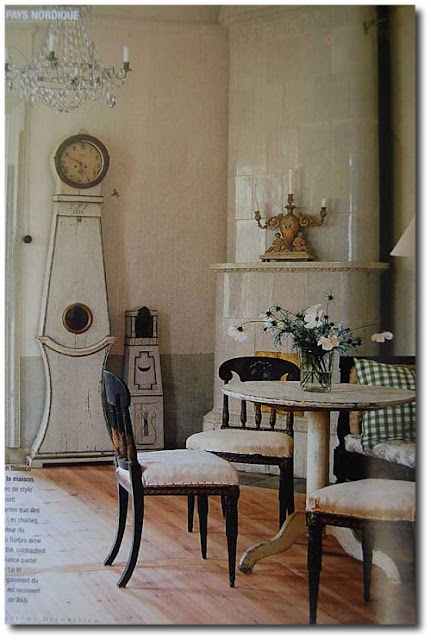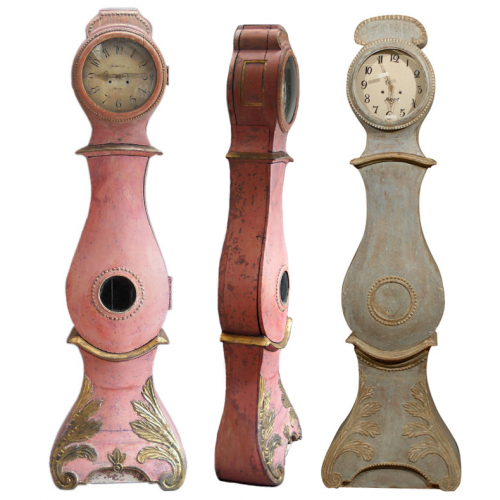I find rooms graced with the presence of Mora clocks to be very peaceful. It is like having a grandmotherly figure on duty to look after you. They just stand there quietly surveying the room and giving a sense of security. I guess it's the fact that Mora clocks are built to resemble a woman's curves – narrow at the waist and fuller at the bust and hips- The feminine answer to the Grandfather clock!
Mora clocks originated in Mora, a town in the central Dalarna region of Sweden which was originally a mining and farming community.When these industries floundered in the mid 1700's the people of Mora reinvented themselves as clockmakers in order to supplement their income. Each family specialized in producing one part of these wonderful clocks. Some made hoods, while others made feet, faces, bodies or took care of the painting.This is why there are no two original Mora clocks exactly alike. By 1800, the Mora clock’s golden age, about 100 families were involved in the town’s enterprise and it is said there were about 50 000 clocks produced during their heyday in the 1800's.
Mora clocks have a timeless appeal and that coupled with the fact that they work beautifully in almost every interior style keeps them on the perennial favorite list.
Just utter the words Swedish or Gustavian style and the image that immediately leaps to mind is of the iconic Mora clock.
Swedish furniture styles have increased in popularity and the Moro Clock is one of the most identifiable furniture pieces associated with this style of decorating.
In the countryside gracefully carved Mora clocks were white-washed, or painted pearl gray or soft butter cream. Their simple beauty rivaling the gilded furniture found in royal palaces.
Today you can expect to pay large amounts for original Mora clocks but the care and craftsmanship that went into creating them makes it all worthwhile.
Alice Lane Home Collections
This Mora clock makes quite an impression and holds it's own against a fabulous staircase.
The hood of the Mora clock is the bentwood bonnet that surrounds the face.
A Mora clock hood often has ornamentation on top. The one seen in this image features spikes
While this Mora just revels in it's simplicity.
Part of the Mora clock's appeal lies in the way it can beautifully blend in anywhere from folk art to formal.
Grey and cream finishes on Mora clocks are particularity popular. These finishes are perfect for Gustavian styling which uses muted whites, Swedish greys and blues with a touch of gold gilt.
While not the only treatment, the most common way to finish a Mora clock is with a simple flat paint.
You can count on a Mora clock to become the visual focal point in any room.
I adore Mora clocks that are built into desks and cupboards. They are still gorgeous, just in a different form!
Some Mora clocks have hand-painted folk art designs called kurbits or jamtland. Brightly painted, they have a more rustic appeal.
The handmade imperfections and flaking paint finishes of old age is part of the magic of a Mora clock.
This salmon pink Mora clock is absolutely stunning!
via Pinterest
Adding value to an original Mora clock’s wonderful finish is the bubbles and inconsistencies in the original antique glass.
A Mora clock does not have the deep, resounding dong of other case clocks. Instead it has an enchantingly light tinkling chime made by one or two bells.
Mora clocks don't have to be used in predominately white Swedish interiors only. If you like color, they work wonderfully in rooms decked out in colorful French toiles........
Marshall Watson and Jeffrey Kilmer
........or buffalo plaid and gingham.
via Pinterest
Mora clocks can blend in with traditional interiors that are decorated with colorful wallpapers and upholstery.
Mora clock faces are often marked with the inscription "A A S Mora"—the initials of Krång Anders Andersson (1727-1799) of Ostnor traditionally known as the first clockmaker in the district of Mora.
ebay.com
You can expect to pay thousands for an original Mora clock, however reproductions can be found in the $800 range. Yellow is another paint finish you might consider if you don't want the all neutral interior. Yellow would look good in a French country style space where yellow, blue and red are popular colors.
This black and gilded Mora clock is especially appealing to me.! I would love to have this one.
Another beautiful example of a hand painted Mora clock, this one in white.
A Mora clock is that special piece you want pass down to future generations.
Pamela Pierce
.I love the height, shapeliness, and touch of whimsy a Mora clock brings to a room.









































